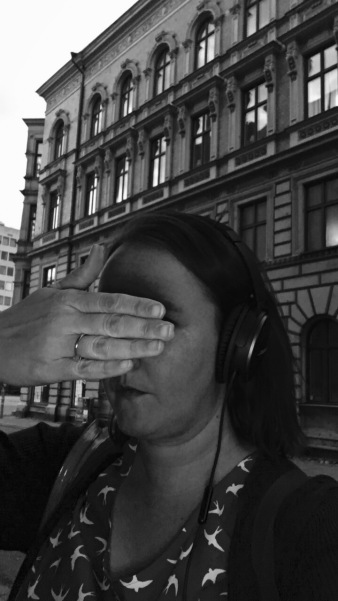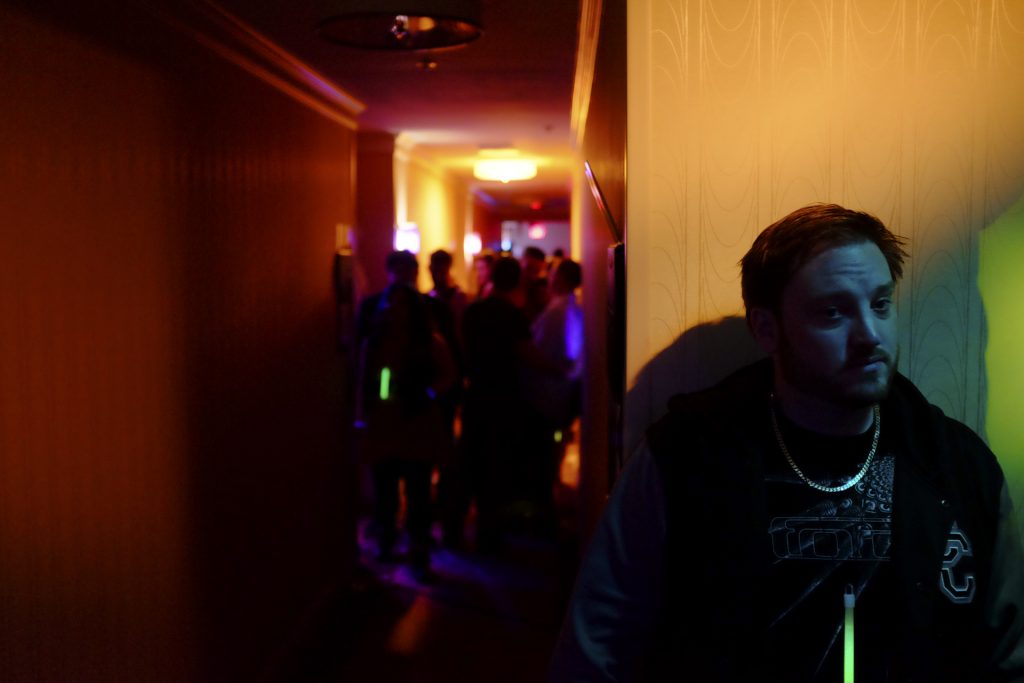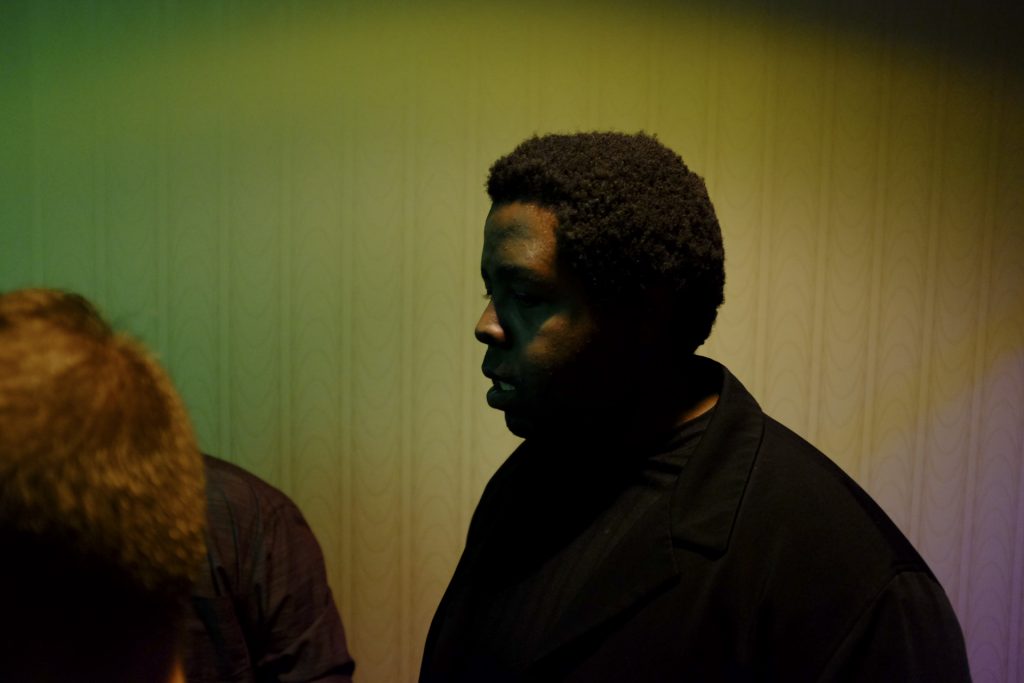This is the third in a series of posts about the safety and calibration systems used in the New Orleans run of the larp End of the Line. The first was about the OK Check-in and the second about the Tap-Out. The discussion of the Lookdown continues in my next post.
The Lookdown is a bow-out mechanic – that is, a calibration mechanic that allows individual players to fluidly opt out of scenes that other participants are actively engaging in. At End of the Line we used it in two ways:
- as a visual cue that the player (rather than the character) was opting out of a situation. Let’s say I as a player walk into a room where sex acts are being simulated. It’s obviously not for real, but it looks real enough, and while everyone else is larping like mad, I perhaps realize that whatever my character feels at the sight (shock, dismay, excitement, inspiration) is not what I feel interested in playing on right now. Then I can use the Lookdown while leaving the room to signal, basically, that the other characters should not follow my character.
- as a parallel to the Tap-Out. In End of the Line the Lookdown was how you tapped out if you could not reach the person you were playing with, or if you were interacting with a number of players simultaneously and tapping out seemed impractical. It followed the exact same two step procedure as the Tap-Out, outlined below under “Basic Procedure”.
It is absolutely possible to use the Lookdown exclusively for meaning number one (which is what, for instance, New World Magischola did – with an interesting tweak, see further below).
The point of the first usage is to allow for a distinction between:
- your character being upset and leaving, in which case interesting play is generated only if someone sees this and reacts to it (ideally coming to talk to your character about it, or to beat them up, or whatever fits) and
- you the player choosing not to engage, in which case of course you do not wish to be interacted with about that.
To enable play on character upset, then, a hand sign to indicate the player is extracting herself from a situation makes perfect sense. This is the “classic” Lookdown, and if you use it in your larp, you will most often give the gesture this meaning only.
However, it is also possible to use the gesture in the way outlined under point 2 above – “parallel to Tap-Out”. The existence of the second usage, then of course also allows the potential third option of using Lookdown as the only gesture for “tap-out” (that is, using Lookdown without allowing the shoulder-tapping gesture). This makes sense in some settings, but not in End of the Line, where many intense situations, like neck-biting, would mean the participants can’t see each other. We needed some kind of tap-out mechanic to allow for continuous calibration within scenes, and decided to go with the ordinary Tap-Out for that.
We also had Lookdown in play in its first meaning, “I do not want to see/play on this”. Therefore, when we realized we also needed a “no-touch” Tap Out, we decided to activate that as an additional meaning for the Lookdown gesture, instead of introducing some additional hand sign. When designing any kind of rules system, especially rules or mechanics to be used in an agitated state, minimizing cognitive load is an important design parameter. Which is big words for “have as few mechanics as possible and make them really easy to remember and use”.
Basic Procedure
 To perform the lookdown, you raise your hand clearly in front of your eyes like the See No Evil monkey. It makes sense to not actually shield your eyes, so you can see what’s happening in the room, which in practice means you’d keep your hand at brow level and kind of peek out under it (looking down, get it?) or have your hand slightly further away from your face and peek over it. I can’t believe I just used five lines to explain something that you figure out for yourself in a second.
To perform the lookdown, you raise your hand clearly in front of your eyes like the See No Evil monkey. It makes sense to not actually shield your eyes, so you can see what’s happening in the room, which in practice means you’d keep your hand at brow level and kind of peek out under it (looking down, get it?) or have your hand slightly further away from your face and peek over it. I can’t believe I just used five lines to explain something that you figure out for yourself in a second.
- If you then turn around and leave, you have used the Lookdown in its first meaning – to opt out of a scene, signalling to the people playing in the scene that they should not follow you, but also not stop – “keep playing, you guys, I’m cool over here”.
- In the larps I’m involved with, usually this means both the player and the character leaves the situation. For this to work seamlessly, it has to be feasible for any character to walk away from any scene. You can read a little bit more about this in the previous post, which was about about tapping out.
- If you remain in the situation – assuming of course that the larp is using the Lookdown as a parallel to the Tap-Out – the tap-out procedure is activated as follows.
- If someone gestures “Lookdown” and remains in the room, it is essentially a Tap-Out, and everyone stops what they’re doing. Most importantly, if you are holding someone, you release them, to allow them to leave the scene and the room if they want to.
- If they need to go, they are allowed to go, no questions asked.
- If they stay, it means they’d like to continue the scene, but with just a little less of whatever was going on. Less screaming, less sexuality, less restriction of movement… Everyone dials it down a bit, and play continues, no OOC language required. (Unless it is required, in which case you speak, but see below)
- Please remember – no matter whether the player stays or goes, DON’T ASK WHY, DON’T SAY WHY. Not talking about why has a double function. It avoids the creation of a hierarchy of differently valid reasons for self-care. It also creates social protection for people who tap out for very private reasons that they may not want to share.
- If your mechanics allow for playstyle negotiations, like those of End of the Line did, the player who has looked down (or effectively, tapped out) may offer suggestions on playstyle as long as they don’t say why they have that preference. For instance, “can we continue but without you blocking me in physically? The screaming is fine, you can scream more if you’d like”. It is equally possible to use the Lookdown without allowing this option. As always, it depends on your overall safety design.
Credits, Background & Variants

The “See No Evil” or “Lookdown” is a calibration technique invented this spring in a bar in Oslo, Norway, during a conversation between myself and a bunch of people, in particular Trine Lise Lindahl who suggested the gesture. A few weeks later in Austin, Texas, I mentioned the technique in my talk at Living Games, from whence it immediately got picked up for some games, including most importantly New World Magischola, where it was also named the Lookdown. NWM’s beatifully integrated safety and calibration systems were by Maury Brown, Sarah Lynne Bowman and Harrison Greene, and have been documented here.
An interesting variant emerged at NWM, where the Lookdown gesture was used, for instance, if a character was late for class, but the player did not want play on their tardiness. (The gesture then doubled as both an “I as a player actually don’t want to see this” and an “I as a player actually don’t want to be seen”). This can make a bunch of sense for all kinds of reasons; maybe the player is late for some medical or other self-care reason and has no energy to get their characters’ head chewed off for something that has nothing to do with the fiction. That said, NWM is a collaborative style larp with a sandbox style and “play for what’s interesting” aesthetic. Just like at End of the Line, getting your character in trouble was explicitly given as advice for a fun experience.
I willingly admit that this “please don’t see me” usage rubs me personally the wrong way, because from the perspective of my larp tradition, why would you ever want to opt out of an opportunity for an interesting scene? Similarly I know many American larpers who worry that more competitive games will break if players have an opportunity of opting out of in-game consequences. (In my original post on this topic, you can read about how a fix to an almost identical mechanic is deployed to counter this worry at Texan Planetfall).
Obviously, when I stop to think for one second, I can think of quite a lot of reasons why being able to slip back into a scene unquestioned is as important as being allowed to slip out as needed. And of course, as I’ve said many times before, what reasons you as a play collective allow for pausing play or opting out of scenes is up to you – but you will usually need a way for players to step out without breaking the larp entirely, for medical and babysitter emergencies if nothing else. Right up there with those practical hard limits in importance is the understanding that players are more important than larps. If a player, for whatever reason, is so agitated they feel they must stop playing, they are per definition not in a state where they are able to play. Which means you need some tool for handling this (as well as a reasonable focus on preventing it).
As always though, these tools are deployed in systems. This means that if New World Magischola was played with exclusively Nordic players, they would have an implicit cultural norm establishing that when I the player am late for in-game class, I will invent some reason for my character to be late also, and then we’d embrace whatever interesting plot that threw our way.
Of course this only works if I trust the players of the classmates and teachers also are playing for what is interesting. If they’re on some kind of power trip about humiliating people and blocking them from plot & play for kicks, then I would not be willing to take that risk. (I’m sure the NWM playstyle isn’t actually like that, but I suspect many players with bad experiences from competitive larps did not fully trust that good and fun play would always emerge from getting your character in trouble).
As always, then, safety and calibration designs have to be understood in the wider context of game mechanics, fictional culture norms, play culture norms, and community design. In the next part of this series, I consider the deployment of the Lookdown in different kinds of systems.

While sometimes worry about other players’ reactions causes someone to want to do something on the player level but not the character level, I’ve also seen it sometimes when players are just very keen on being “in character” and don’t think their character would use the bathroom/accept food in this situation. Supporting players taking care of themselves regardless of the in-universe situation is good, regardless.